Aphid Resistance in Pisum Affects the Feeding Behavior of Pea-Adapted and Non-Pea-Adapted Biotypes of Acyrthosiphon pisum Differently
Abstract
:Simple Summary
Abstract
1. Introduction
2. Materials and Methods
2.1. Plants and Insects
2.2. Aphid Body Mass Measurements on the Six Pisum Genotypes
2.3. Aphid Feeding Behavior Monitored by EPG
2.4. Statistical Analysis
3. Results
3.1. Variation in Aphid Body Mass on Pisum Genotypes
3.2. Difference in Feeding Behavior between A. pisum Biotypes on the Six Pisum Genotypes
3.3. Comparison of the Feeding Behavior between the Two Aphid Biotypes
4. Discussion
5. Conclusions
Supplementary Materials
Author Contributions
Funding
Institutional Review Board Statement
Acknowledgments
Conflicts of Interest
References
- Dogimont, C.; Chovelon, V.; Pauquet, J.; Boualem, A.; Bendahmane, A. The Vat locus encodes for a CC-NBS-LRR protein that confers resistance to Aphis gossypii infestation and A. gossypii-Mediated virus resistance. Plant J. 2014, 80, 993–1004. [Google Scholar] [CrossRef] [PubMed]
- Rossi, M.; Goggin, F.L.; Milligan, S.B.; Kaloshian, I.; Ullman, D.E.; Williamson, V.M. The nematode resistance gene Mi of tomato confers resistance against the potato aphid. Proc. Natl. Acad. Sci. USA 1998, 95, 9750–9754. [Google Scholar] [CrossRef] [PubMed] [Green Version]
- Liang, L.; Liu, L.; Yu, X.; Han, B. Evaluation of the resistance of different tea cultivars to tea aphids by EPG technique. J. Integr. Agric. 2012, 11, 2028–2034. [Google Scholar] [CrossRef]
- Pointeau, S.; Ameline, A.; Sallé, A.; Bankhead-Dronnet, S.; Lieutier, F. Characterization of antibiosis and antixenosis to the woolly poplar aphid (Hemiptera: Aphididae) in the bark of different poplar genotypes. J. Econ. Entomol. 2013, 106, 473–481. [Google Scholar] [CrossRef]
- Chen, J.Q.; Rahbé, Y.; Delobel, B.; Sauvion, N.; Guillaud, J.; Febvay, G. Melon resistance to the aphid Aphis gossypii: Behavioural analysis and chemical correlations with nitrogenous compounds. Entomol. Exp. Appl. 1997, 85, 33–44. [Google Scholar] [CrossRef]
- Garzo, E.; Soria, C.; Gómez-Guillamón, M.L.; Fereres, A. Feeding behavior of Aphis gossypii on resistant accessions of different melon genotypes (Cucumis melo). Phytoparasitica 2002, 30, 129–140. [Google Scholar] [CrossRef]
- Pallipparambil, G.R.; Reese, J.C.; Avila, C.A.; Louis, J.M.; Goggin, F.L. Mi-mediated aphid resistance in tomato: Tissue localization and impact on the feeding behavior of two potato aphid clones with differing levels of virulence. Entomol. Exp. Appl. 2010, 135, 295–307. [Google Scholar] [CrossRef]
- Panstruga, R.; Moscou, M.J. What is the molecular basis of nonhost resistance? Mol. Plant-Microbe Interact. 2020, 33, 1253–1264. [Google Scholar] [CrossRef]
- Escudero-Martinez, C.; Leybourne, D.J.; Bos, J.I.B. Plant resistance in different cell layers affects aphid probing and feeding behaviour during non-host and poor-host interactions. Bull. Entomol. Res. 2021, 111, 31–38. [Google Scholar] [CrossRef]
- Peccoud, J.; Mahéo, F.; de la Huerta, M.; Laurence, C.; Simon, J.-C. Genetic characterisation of new host-specialised biotypes and novel associations with bacterial symbionts in the pea aphid complex. Insect Conserv. Divers. 2015, 8, 484–492. [Google Scholar] [CrossRef]
- Peccoud, J.; Ollivier, A.; Plantegenest, M.; Simon, J.-C. A Continuum of genetic divergence from sympatric host races to species in the pea aphid complex. Proc. Natl. Acad. Sci. USA 2009, 106, 7495–7500. [Google Scholar] [CrossRef] [PubMed] [Green Version]
- Siol, M.; Jacquin, F.; Chabert-Martinello, M.; Smýkal, P.; Le Paslier, M.-C.; Aubert, G.; Burstin, J. Patterns of genetic structure and linkage disequilibrium in a large collection of pea germplasm. G3 Genes Genomes Genet. 2017, 7, 2461–2471. [Google Scholar] [CrossRef] [PubMed] [Green Version]
- Ollivier, R.; Glory, I.; Cloteau, R.; Le Gallic, J.F.; Denis, G.; Morlière, S.; Miteul, H.; Rivière, J.P.; Lesné, A.; Klein, A.; et al. A major-effect genetic locus, ApRVII, controlling resistance against both adapted and non-adapted aphid biotypes in pea. Theor. Appl. Genet. 2022, 135, 1–18. [Google Scholar] [CrossRef] [PubMed]
- Schwarzkopf, A.; Rosenberger, D.; Niebergall, M.; Gershenzon, J.; Kunert, G. To feed or not to feed: Plant factors located in the epidermis, mesophyll, and sieve elements influence pea aphid’s ability to feed on legume species. PLoS ONE 2013, 8, e75298. [Google Scholar] [CrossRef] [Green Version]
- Tjallingii, W.F. Electrical recording of stylet penetration activities. In Aphids, Their Biology, Natural Enemies and Control; Minks, A.K., Harrewijn, P., Eds.; Elsevier Science Publishers: Amsterdam, The Netherlands, 1988; pp. 95–108. [Google Scholar]
- Tjallingii, W.F. Electronic recording of penetration behaviour by aphids. Entomol. Exp. Appl. 1978, 24, 721–730. [Google Scholar] [CrossRef]
- Giordanengo, P. EPG-Calc: A PHP-based script to calculate Electrical Penetration Graph (EPG) parameters. Arthropod-Plant Interact. 2014, 8, 163–169. [Google Scholar] [CrossRef]
- Bogaert, F.; Chesnais, Q.; Catterou, M.; Rambaud, C.; Doury, G.; Ameline, A. How the use of nitrogen fertiliser may switch plant suitability for aphids: The case of Miscanthus, a promising biomass crop, and the aphid pest Rhopalosiphum maidis: Nitrogen fertiliser and the miscanthus-aphid complex. Pest Manag. Sci. 2017, 73, 1648–1654. [Google Scholar] [CrossRef]
- Nylin, S.; Gotthard, K. Plasticity in life-history traits. Annu. Rev. Entomol. 1998, 43, 63–83. [Google Scholar] [CrossRef] [Green Version]
- Roff, D. Evolution of Life Histories: Theory and Analysis; Springer Science & Business Media: Berlin/Heidelberg, Germany, 1993. [Google Scholar]
- Peccoud, J.; Simon, J.-C.; von Dohlen, C.; Coeur d’acier, A.; Plantegenest, M.; Vanlerberghe-Masutti, F.; Jousselin, E. Evolutionary history of aphid-plant associations and their role in aphid diversification. Comptes Rendus Biol. 2010, 333, 474–487. [Google Scholar] [CrossRef]
- Goławska, S. Deterrence and toxicity of plant saponins for the pea aphid Acyrthosiphon pisum Harris. J. Chem. Ecol. 2007, 33, 1598–1606. [Google Scholar] [CrossRef]
- Goławska, S.; Łukasik, I.; Leszczyński, B. Effect of alfalfa saponins and flavonoids on pea aphid. Entomol. Exp. Appl. 2008, 128, 147–153. [Google Scholar] [CrossRef]
- Goławska, S.; Łukasik, I. Antifeedant activity of luteolin and genistein against the pea aphid, Acyrthosiphon pisum. J. Pest Sci. 2012, 85, 443–450. [Google Scholar] [CrossRef] [Green Version]
- Goławska, S.; Łukasik, I. Acceptance of low-saponin lines of alfalfa with varied phenolic concentrations by pea aphid (Homoptera: Aphididae). Biologia 2009, 64, 377–382. [Google Scholar] [CrossRef]
- Powell, G.; Tosh, C.R.; Hardie, J. Host plant selection by aphids: Behavioral, evolutionary, and applied perspectives. Annu. Rev. Entomol. 2006, 51, 309–330. [Google Scholar] [CrossRef] [PubMed]
- Silva-Sanzana, C.; Celiz-Balboa, J.; Garzo, E.; Marcus, S.E.; Parra-Rojas, J.P.; Rojas, B.; Olmedo, P.; Rubilar, M.A.; Rios, I.; Chorbadjian, R.A.; et al. Pectin methylesterases modulate plant homogalacturonan status in defenses against the aphid Myzus persicae. Plant Cell 2019, 31, 1913–1929. [Google Scholar] [CrossRef] [Green Version]
- Klingler, J.; Powell, G.; Thompson, G.A.; Isaacs, R. Phloem specific aphid resistance in Cucumis melo line AR 5: Effects on feeding behaviour and performance of Aphis gossypii. Entomol. Exp. Appl. 1998, 86, 79–88. [Google Scholar] [CrossRef] [Green Version]
- Ramírez, C.C.; Niemeyer, H.M. Salivation into sieve elements in relation to plant chemistry: The case of the Aphid Sitobion fragariae and the wheat, Triticum aestivum. Entomol. Exp. Appl. 1999, 91, 111–114. [Google Scholar] [CrossRef]
- Sauge, M.-H.; Lacroze, J.-P.; Poëssel, J.-L.; Pascal, T.; Kervella, J. Induced resistance by Myzus persicae in the peach cultivar ‘Rubira’. Entomol. Exp. Appl. 2002, 102, 29–37. [Google Scholar] [CrossRef]
- Garzo, E.; Moreno, A.; Plaza, M.; Fereres, A. Feeding behavior and virus-transmission ability of insect vectors exposed to systemic insecticides. Plants 2020, 9, 895. [Google Scholar] [CrossRef]
- Machado-Assefh, C.R.; Lopez-Isasmendi, G.; Tjallingii, W.F.; Jander, G.; Alvarez, A.E. Disrupting Buchnera aphidicola, the endosymbiotic bacteria of Myzus persicae, delays host plant acceptance. Arthropod-Plant Interact. 2015, 9, 529–541. [Google Scholar] [CrossRef]
- Tjallingii, W.F. Salivary secretions by aphids interacting with proteins of phloem wound responses. J. Exp. Bot. 2006, 57, 739–745. [Google Scholar] [CrossRef] [PubMed]
- Will, T.; Vilcinskas, A. The structural sheath protein of aphids is required for phloem feeding. Insect Biochem. Mol. Biol. 2015, 57, 34–40. [Google Scholar] [CrossRef] [PubMed]
- Boulain, H.; Legeai, F.; Jaquiéry, J.; Guy, E.; Morlière, S.; Simon, J.-C.; Sugio, A. Differential expression of candidate salivary effector genes in pea aphid biotypes with distinct host plant specificity. Front. Plant Sci. 2019, 10, 1301. [Google Scholar] [CrossRef]
- Eyres, I.; Jaquiéry, J.; Sugio, A.; Duvaux, L.; Gharbi, K.; Zhou, J.-J.; Legeai, F.; Nelson, M.; Simon, J.-C.; Smadja, C.M.; et al. Differential gene expression according to race and host plant in the pea aphid. Mol. Ecol. 2016, 25, 4197–4215. [Google Scholar] [CrossRef] [PubMed]
- Rao, S.A.K.; Carolan, J.C.; Wilkinson, T.L. Proteomic profiling of cereal aphid saliva reveals both ubiquitous and adaptive secreted proteins. PLoS ONE 2013, 8, e57413. [Google Scholar] [CrossRef]
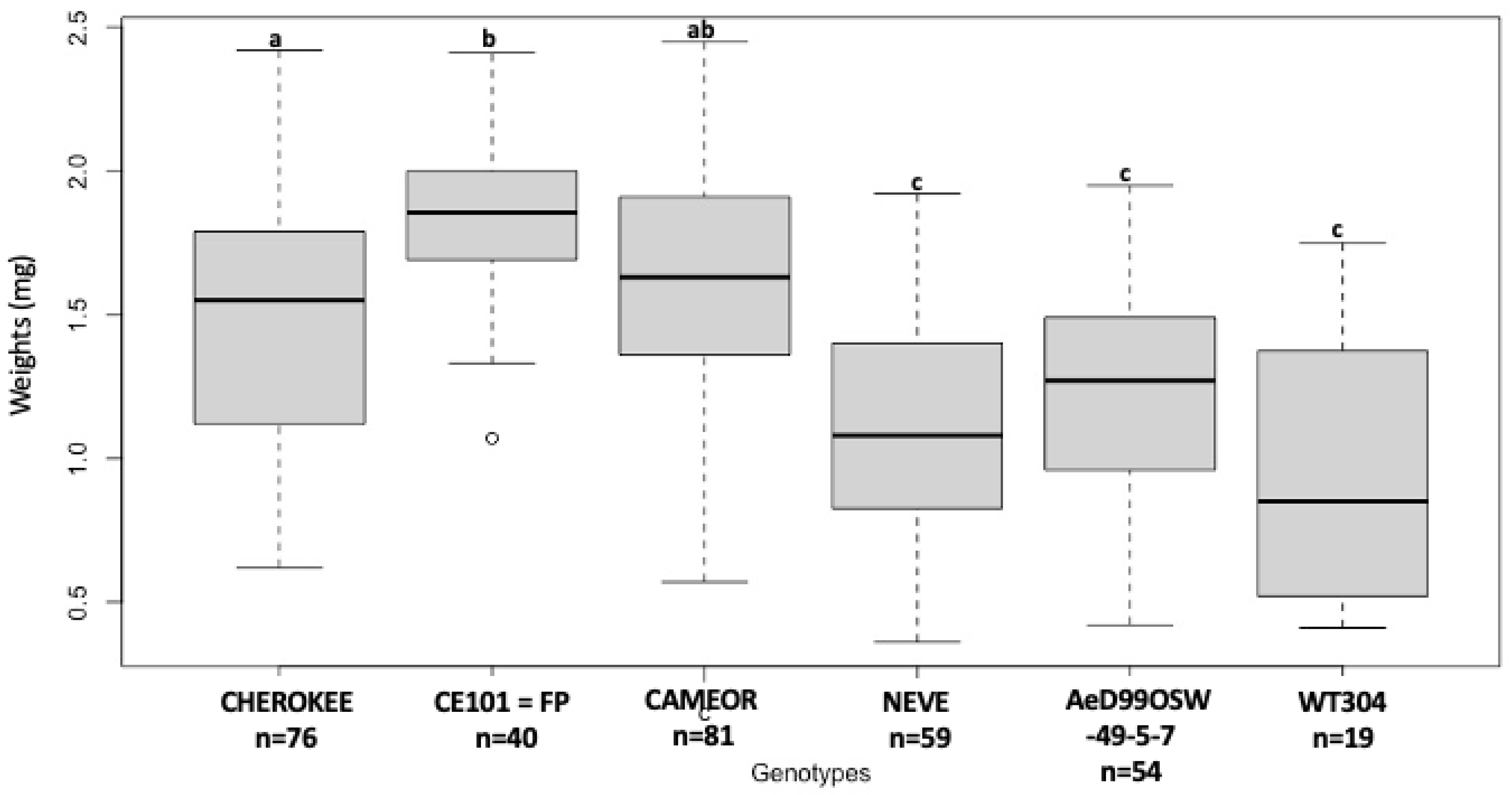
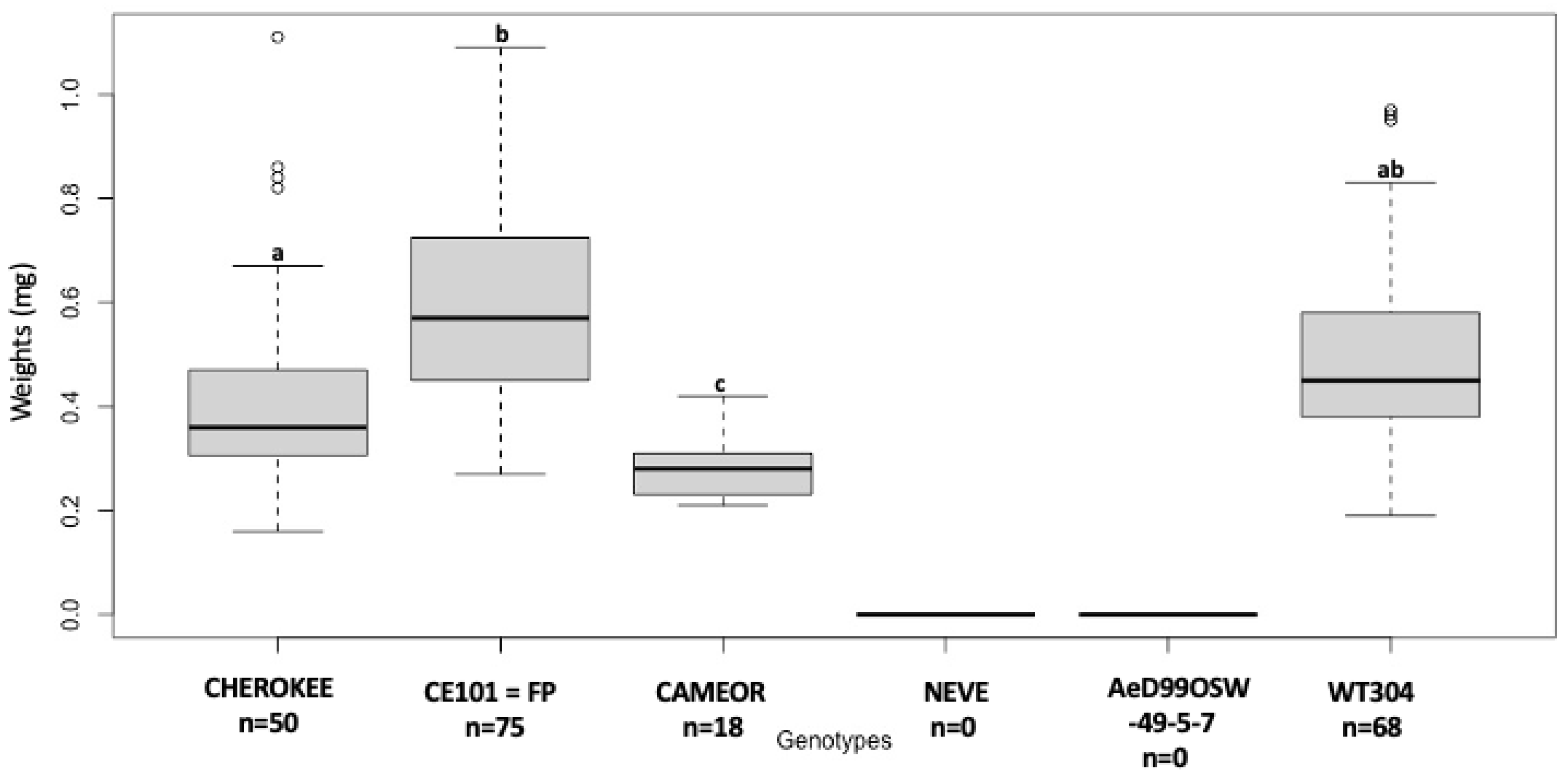

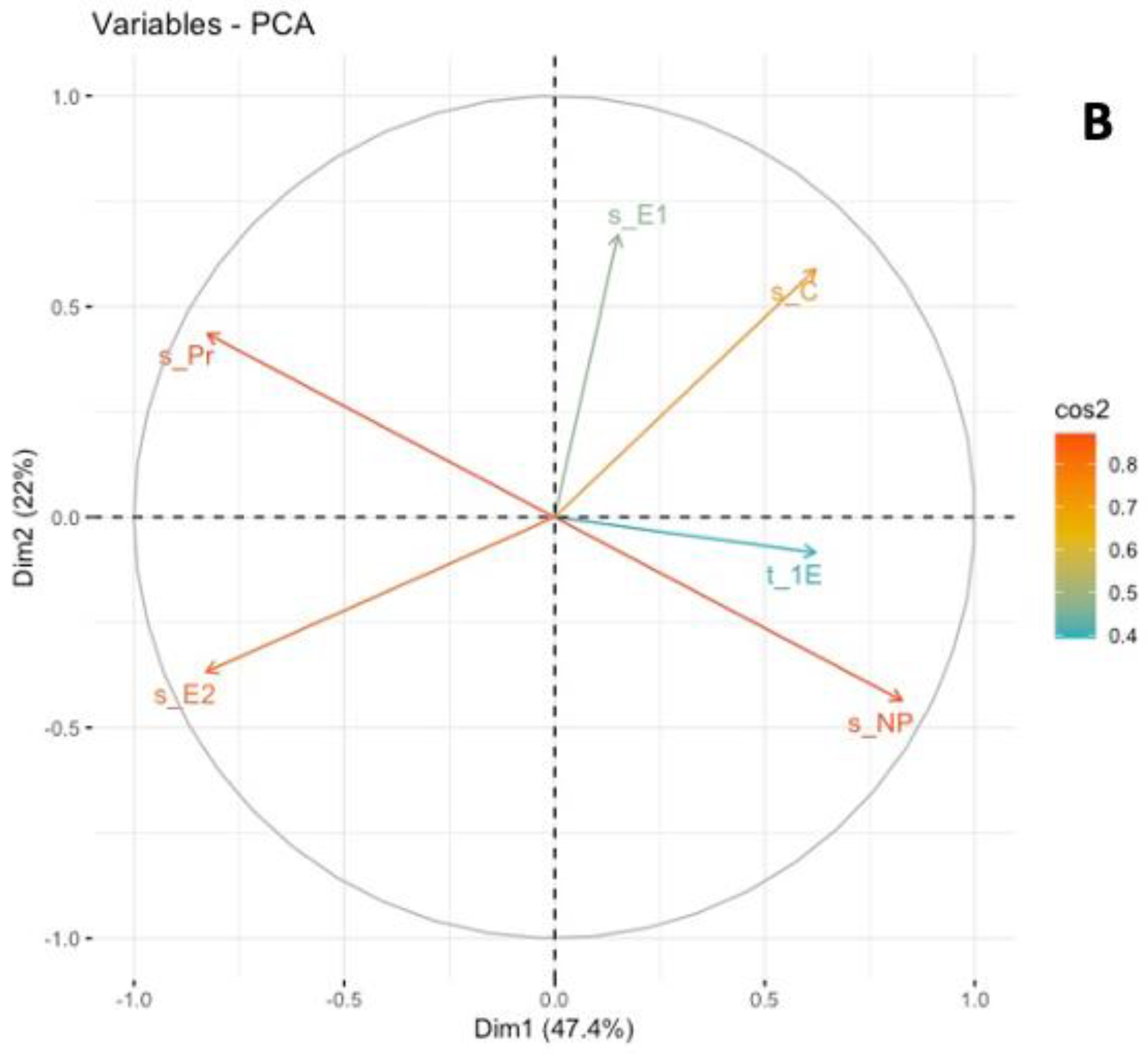
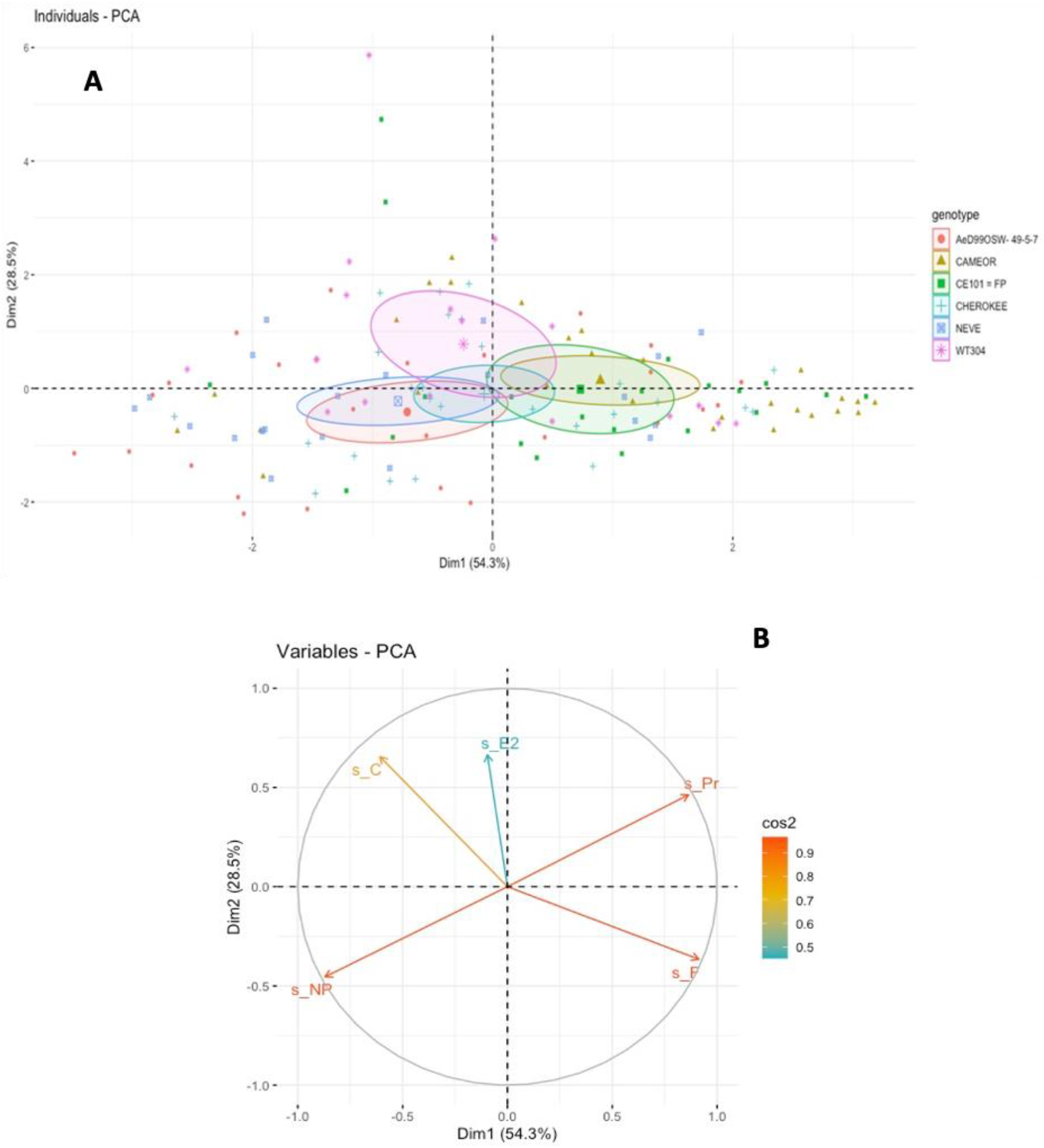
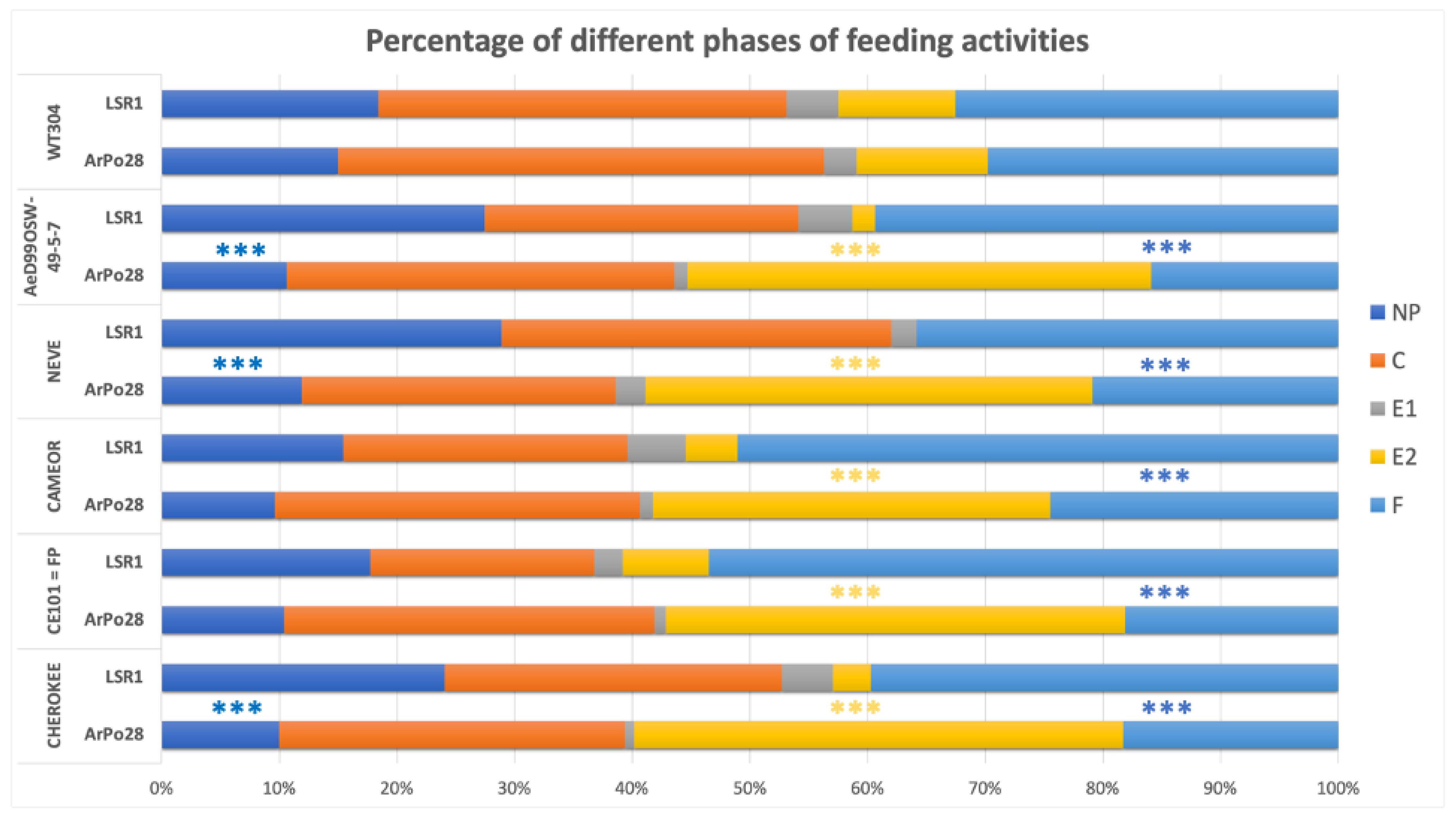
| Pea Aphid ArPo28 | Pisum fulvum | Pisum sativum | |||||
|---|---|---|---|---|---|---|---|
| Kruskal-Wallis Test H(P) | WT304 | AeD99OSW- 49-5-7 | NEVE | CAMEOR | CE101 = FP | CHEROKEE | |
| General phases | |||||||
| Total duration of non-probing | |||||||
| (min. s_NP) | 13.56 (*) | 86 ± 9 a | 47 ± 7 b | 58 ± 13 ab | 53 ± 11 b | 55 ± 12 b | 54 ± 11 ab |
| n = | 31 | 20 | 22 | 28 | 29 | 22 | |
| Total duration of probing | |||||||
| (min. s_Pr) | 13.97 (*) | 394 ± 10 a | 422 ± 15 b | 414 ± 14 ab | 427 ± 11 b | 425 ± 12 b | 426 ± 10 b |
| n = | 31 | 20 | 22 | 28 | 29 | 22 | |
| Time to first probe | |||||||
| (min. t > 1 Pr) | 1.52 (NS) | 12 ± 3 | 9 ± 3 | 18 ± 9 | 11 ± 5 | 14 ± 4 | 15 ± 5 |
| n = | 31 | 20 | 22 | 28 | 29 | 22 | |
| Pathway phases (C) | |||||||
| Total duration of pathway phase | |||||||
| (min. s_C) | 17.64 (**) | 237 ± 15 a | 180 ± 21 b | 148 ± 24 b | 171 ± 16 b | 167 ± 12 b | 159 ± 16 b |
| n = | 31 | 20 | 22 | 28 | 29 | 22 | |
| Phloem phases (E) | |||||||
| Total duration of salivation phase (min. s_E1) | 7.59 (NS) | 16 ± 3 | 6 ± 1 | 14 ± 6 | 6 ± 1 | 5 ± 0 | 4 ± 1 |
| n = | 25 | 17 | 18 | 25 | 26 | 20 | |
| Total duration of phloem ingestion (min. s_E2) | 35.04 (***) | 64 ± 10 a | 215 ± 28 b | 211 ± 31 b | 186 ± 17 b | 207 ± 21 b | 225 ± 25 b |
| n = | 22 | 17 | 18 | 24 | 26 | 19 | |
| Time to first phloem phase | |||||||
| (min. t > 1 E) | 11.30 (*) | 281 ± 30 a | 168 ± 31 b | 164 ± 28 b | 226 ± 21 b | 222 ± 21 b | 192 ± 21 b |
| n = | 23 | 17 | 17 | 24 | 26 | 19 | |
| Other phases (F) | |||||||
| Total duration of derailed stylet phase (min. s_F) | 7.43 (NS) | 171 ± 28 | 87 ± 22 | 116 ± 29 | 135 ± 24 | 96 ± 14 | 99 ± 23 |
| n = | 16 | 8 | 9 | 17 | 22 | 9 | |
| Alfalfa Biotype (LSR1) | Pisum fulvum | Pisum sativum | |||||
|---|---|---|---|---|---|---|---|
| Kruskal-Wallis Test H(P) | WT304 | AeD99OSW- 49-5-7 | NEVE | CAMEOR | CE101 = FP | CHEROKEE | |
| General phases | |||||||
| Total duration of non-probing (min.s_NP) | 22.43 (***) | 103 ± 11 ab | 151 ± 16 a | 148 ± 16 a | 77 ± 14 b | 93 ± 13 b | 120 ± 11 ab |
| n = | 18 | 25 | 21 | 28 | 20 | 26 | |
| Total duration of probing | |||||||
| (min. s_Pr) | 22.59 (***) | 376 ± 11 ab | 324 ± 17 a | 331 ± 15 a | 386 ± 13 b | 402 ± 13 b | 359 ± 11 ab |
| n = | 18 | 25 | 21 | 28 | 20 | 26 | |
| Time to first probe | |||||||
| (min. t > 1 Pr) | 3.09 (NS) | 21 ± 7 | 23 ± 9 | 16 ± 6 | 18 ± 6 | 8 ± 2 | 17 ± 7 |
| n = | 18 | 25 | 21 | 28 | 20 | 26 | |
| Pathway phases (C) | |||||||
| Total duration of pathway phase (min. s_C) | 15.66 (**) | 196 ± 24 a | 152 ± 19 ab | 171 ± 17 ab | 101 ± 18 b | 122 ± 17 b | 144 ± 16 ab |
| n = | 18 | 25 | 21 | 28 | 20 | 26 | |
| Phloem phases (E) | |||||||
| Total duration of salivation phase (min. s_E1) | 4.57 (NS) | 25 ± 10 | 26 ± 12 | 11 ± 5 | 13 ± 4 | 25 ± 6 | 22 ± 5 |
| n = | 10 | 8 | 9 | 12 | 15 | 11 | |
| Total duration of phloem ingestion (min. s_E2) | 8.16 (NS) | 56 ± 34 | 11 ± 3 | - | 39 ± 23 | 22 ± 5 | 16 ± 3 |
| n = | 4 | 2 | 0 | 5 | 6 | 6 | |
| Time to first phloem phase | |||||||
| (min. t > 1 E) | 4.93 (NS) | 421 ± 33 | 474 ± 5 | - | 283 ± 67 | 300 ± 63 | 347 ± 40 |
| n = | 4 | 2 | 0 | 5 | 6 | 6 | |
| Other phases (F) | |||||||
| Total duration of derailed stylet phase (min. s_F) | 15.04 (*) | 184 ± 32 a | 224 ± 24 ab | 185 ± 23 a | 258 ± 29 ab | 284 ± 26 b | 200 ± 20 ab |
| n = | 15 | 18 | 17 | 28 | 18 | 26 | |
Publisher’s Note: MDPI stays neutral with regard to jurisdictional claims in published maps and institutional affiliations. |
© 2022 by the authors. Licensee MDPI, Basel, Switzerland. This article is an open access article distributed under the terms and conditions of the Creative Commons Attribution (CC BY) license (https://creativecommons.org/licenses/by/4.0/).
Share and Cite
González, M.G.; Simon, J.C.; Sugio, A.; Ameline, A.; Cherqui, A. Aphid Resistance in Pisum Affects the Feeding Behavior of Pea-Adapted and Non-Pea-Adapted Biotypes of Acyrthosiphon pisum Differently. Insects 2022, 13, 268. https://doi.org/10.3390/insects13030268
González MG, Simon JC, Sugio A, Ameline A, Cherqui A. Aphid Resistance in Pisum Affects the Feeding Behavior of Pea-Adapted and Non-Pea-Adapted Biotypes of Acyrthosiphon pisum Differently. Insects. 2022; 13(3):268. https://doi.org/10.3390/insects13030268
Chicago/Turabian StyleGonzález, Mauricio González, Jean Christophe Simon, Akiko Sugio, Arnaud Ameline, and Anas Cherqui. 2022. "Aphid Resistance in Pisum Affects the Feeding Behavior of Pea-Adapted and Non-Pea-Adapted Biotypes of Acyrthosiphon pisum Differently" Insects 13, no. 3: 268. https://doi.org/10.3390/insects13030268
APA StyleGonzález, M. G., Simon, J. C., Sugio, A., Ameline, A., & Cherqui, A. (2022). Aphid Resistance in Pisum Affects the Feeding Behavior of Pea-Adapted and Non-Pea-Adapted Biotypes of Acyrthosiphon pisum Differently. Insects, 13(3), 268. https://doi.org/10.3390/insects13030268






